
Pool of Radiance is a role-playing video game developed and published by Strategic Simulations, Inc (SSI) in 1988. It was the first adaptation of TSR's Advanced Dungeons & Dragons (AD&D) fantasy role-playing game for home computers, becoming the first episode in a four-part series of D&D computer adventure games. The other games in the "Gold Box" series used the game engine pioneered in Pool of Radiance, as did later D&D titles such as the Neverwinter Nights online game. Pool of Radiance takes place in the Forgotten Realms fantasy setting, with the action centered in and around the port city of Phlan.
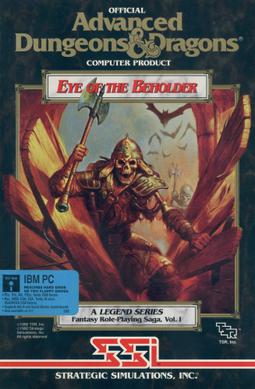
Eye of the Beholder is a role-playing video game for personal computers and video game consoles developed by Westwood Associates. It was published by Strategic Simulations, Inc. in 1991, for the MS-DOS operating system and later ported to the Amiga, the Sega CD and the SNES. The Sega CD version features a soundtrack composed by Yuzo Koshiro and Motohiro Kawashima. A port to the Atari Lynx handheld was developed by NuFX in 1993, but was not released. In 2002, an adaptation of the same name was developed by Pronto Games for the Game Boy Advance.

Pools of Darkness is a role-playing video game published by Strategic Simulations in 1991. The cover art and introduction screen shows a female drow. It is the fourth entry in the Pool of Radiance series of Gold Box games, and the story is a continuation of the events after Secret of the Silver Blades. The novel loosely based on the game was released in 1992. Like the previous games in the series, it is set in the Forgotten Realms, a campaign setting from Dungeons & Dragons. Players must stop an invasion from an evil god, eventually traveling to other dimensions to confront his lieutenants.
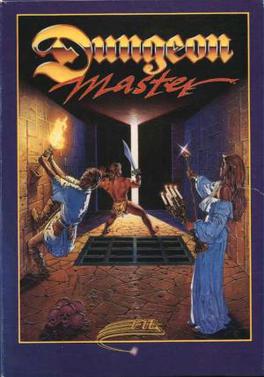
Dungeon Master is a role-playing video game featuring a pseudo-3D first-person perspective. It was developed and published by FTL Games for the Atari ST in 1987, almost identical Amiga and PC (DOS) ports following in 1988 and 1992.

Might and Magic Book One: Secret of the Inner Sanctum is an early role-playing video game, first in the popular and influential Might and Magic franchise. It was released in 1986 as New World Computing's debut, ported to numerous platforms and re-released continuously through the early 1990s.

The Bard's Tale II: The Destiny Knight is a fantasy role-playing video game created by Interplay Productions in 1986. It is the first sequel to The Bard's Tale, and the last game of the series that was designed and programmed by Michael Cranford.

Wizard's Crown is a top-down role-playing video game published by Strategic Simulations in 1986. It was released for the Atari 8-bit computers, Atari ST, IBM PC compatibles, Apple II, and Commodore 64. A sequel, The Eternal Dagger, was released in 1987.
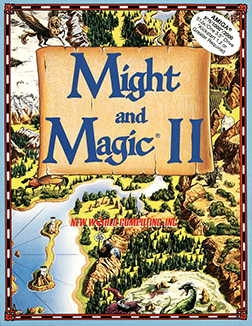
Might and Magic II: Gates to Another World is a role-playing video game developed and published by New World Computing in 1988. It is the sequel to Might and Magic Book One: The Secret of the Inner Sanctum.

Might and Magic IV: Clouds of Xeen is the fourth installment in the Might and Magic series by New World Computing.

Dragon Wars is a fantasy role-playing video game developed by Rebecca Heineman, published by Interplay Productions in 1989, and distributed by Activision.
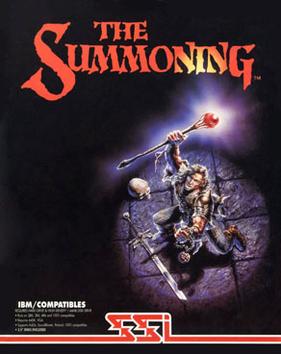
The Summoning is an isometric-view fantasy role-playing video game developed by Event Horizon Software and published by Strategic Simulations in 1992.

J.R.R. Tolkien's The Lord of the Rings, Vol. I is a role-playing video game published by Interplay Productions. It is an adaptation of The Fellowship of the Ring by J. R. R. Tolkien, being the first volume in The Lord of the Rings. The game was released in 1990 for DOS, in 1991 for the Amiga and PC-98, and in 1992 for the FM Towns. It was followed by J.R.R. Tolkien's The Lord of the Rings, Vol. II: The Two Towers. It was originally designed for the Commodore 64, but the production team switched to the newer platforms. The game was designed by Troy A. Miles, Scott Bennie, Jennell Jaquays, and Bruce Schlickbernd. For the later versions, the cutscenes are taken from the 1978 Lord of the Rings film directed by Ralph Bakshi.
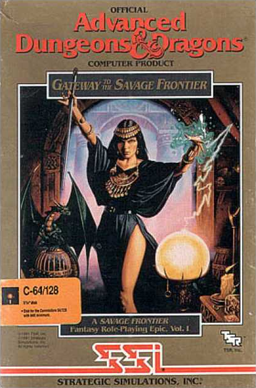
Gateway to the Savage Frontier (1991) is a Gold BoxDungeons & Dragons computer game developed by Beyond Software and published by SSI for the Commodore 64, PC and Amiga personal computers.
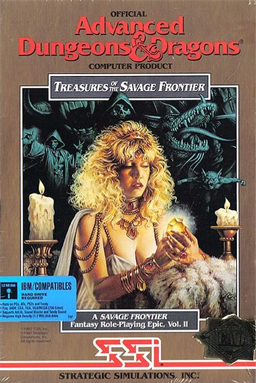
Treasures of the Savage Frontier (1992) is a Gold Box Dungeons & Dragons role-playing video game. It was developed by Beyond Software and published by SSI for the Amiga and DOS.

Wizardry V: Heart of the Maelstrom is the fifth scenario in the Wizardry series of role-playing video games. It was published in 1988 by Sir-Tech for the Commodore 64, Apple II, and IBM PC compatibles. A port for the Super Famicom and FM Towns was later developed and published by ASCII Entertainment in Japan. Wizardry V was released in the US for the Super NES by Capcom in 1993, and subsequently re-released for the Satellaview subsystem under the name BS Wizardry 5.

Champions of Krynn is role-playing video game, the first in a three-part series of Dragonlance Advanced Dungeons & DragonsGold Box games. It was published in 1990 by Strategic Simulations. The highest graphics setting supported in the MS-DOS version is EGA graphics. It also supports the Adlib sound card and either a mouse or joystick.

Death Knights of Krynn is the second in a three-part series of DragonlanceAdvanced Dungeons & Dragons "Gold Box" role-playing video games, published by Strategic Simulations. The game was released in 1991.
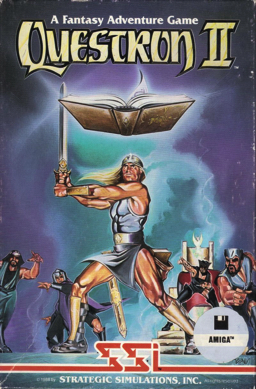
Questron II a 1988 role-playing video game published by Strategic Simulations for the Apple II, Apple IIGS, Atari ST, Commodore 64, IBM PC compatibles, and Amiga. It is the sequel to 1984's Questron. The story and original design is credited to Quest Software, the programming and artwork is credited to Westwood Associates.

Elvira: Mistress of the Dark is a horror adventure/role-playing video game developed by Horror Soft and released by Accolade in 1990 for the Amiga, Atari ST, Commodore 64 and MS-DOS computers. It was Horror Soft's second published game after 1989's Personal Nightmare and stars the actress Cassandra Peterson as her character Elvira.

Phantasie is the first video game in the Phantasie series.




















